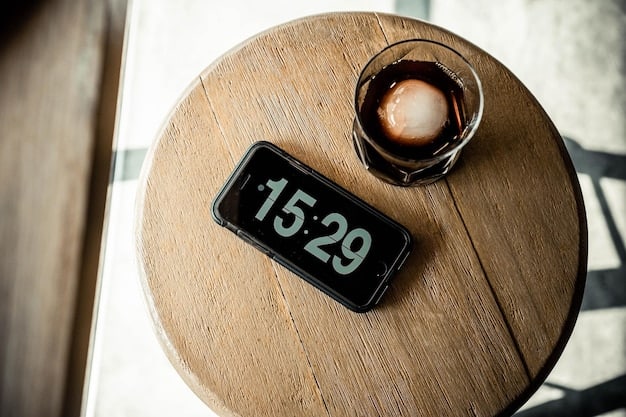Intermittent Fasting for Men: The 16/8 Method Explained (Updated for 2025)

Intermittent Fasting for Men: The 16/8 Method Explained (Updated for 2025) involves eating during an 8-hour window and fasting for 16 hours, potentially aiding weight loss and improving metabolic health, but consulting a healthcare professional is recommended.
Are you looking for a sustainable and effective way to improve your health and fitness? Intermittent Fasting for Men: The 16/8 Method Explained (Updated for 2025) might be the answer. This approach to eating has gained popularity as a way to manage weight, enhance energy levels, and potentially improve overall well-being, but how does it work, actually?
In this comprehensive guide, we’ll delve into the intricacies of the 16/8 intermittent fasting method specifically tailored for men. We’ll explore the science behind it, provide practical tips for getting started, and address common concerns to help you make an informed decision about whether Intermittent Fasting for Men: The 16/8 Method Explained (Updated for 2025) is right for you.
What is Intermittent Fasting for Men: The 16/8 Method Explained (Updated for 2025)?
Intermittent Fasting for Men: The 16/8 Method Explained (Updated for 2025) is a time-restricted eating pattern where you cycle between periods of eating and voluntary fasting on a regular schedule. Specifically, the 16/8 method involves fasting for 16 hours each day and restricting your eating window to 8 hours.
How Does the 16/8 Method Work?
The 16/8 method is relatively simple to follow. You choose an 8-hour window that fits your lifestyle and schedule all your meals within that time frame. For example, you might choose to eat between noon and 8 PM. Outside of this window, you abstain from food but can typically consume water, black coffee, and other calorie-free beverages.
Potential Benefits of Intermittent Fasting
Many men turn to intermittent fasting hoping to achieve certain health benefits. While research is ongoing, some potential benefits include:
- Weight management and fat loss
- Improved insulin sensitivity
- Enhanced cellular repair
- Potential brain health benefits

It’s important to note that individual results may vary, and it’s always best to consult a healthcare professional before making significant dietary changes. In summary, Intermittent Fasting for Men: The 16/8 Method Explained (Updated for 2025) is an eating schedule that may offer different rewards.
Getting Started with Intermittent Fasting for Men: The 16/8 Method Explained (Updated for 2025)
Embarking on any new dietary approach requires careful planning and consideration. Intermittent Fasting for Men: The 16/8 Method Explained (Updated for 2025) is no exception. Here are several points to prepare for it:
Choose Your Eating Window
Selecting the right 8-hour eating window is crucial for adherence and success. Consider your daily routine, work schedule, and social commitments when making your choice. Some men find it easiest to skip breakfast and eat between noon and 8 PM, while others prefer an earlier eating window.
Start Slowly
If you’re new to fasting, it’s wise to ease into the 16/8 method gradually. You could begin by fasting for 12 hours and gradually increasing the fasting window over several days or weeks. This allows your body to adapt and minimizes potential side effects.
Plan Your Meals
Don’t let your eating window become an excuse for unhealthy food choices. Prioritize nutrient-dense foods like fruits, vegetables, lean proteins, and whole grains. Planning your meals in advance can help you stay on track and ensure you’re getting the nutrients you need to support your health and fitness goals, especially during Intermittent Fasting for Men: The 16/8 Method Explained (Updated for 2025).
The 16/8 intermittent fasting journey starts with picking your preferred eating window, a gradual transition, and healthy meal planning. All those factors can impact the potential benefits that Intermittent Fasting for Men: The 16/8 Method Explained (Updated for 2025) can provide.
What to Eat During Your Eating Window
The quality of your diet during your eating window is just as important as the timing of your meals. When practicing Intermittent Fasting for Men: The 16/8 Method Explained (Updated for 2025), focus on consuming nutritious, whole foods that support your health and fitness goals.
Prioritize Protein
Protein is essential for muscle building, repair, and satiety. Include protein-rich foods like lean meats, poultry, fish, eggs, beans, and lentils in your meals. Aim for at least 0.8 grams of protein per kilogram of body weight per day.
Load Up on Fruits and Vegetables
Fruits and vegetables are packed with vitamins, minerals, antioxidants, and fiber. Choose a variety of colorful fruits and vegetables to ensure you’re getting a wide range of nutrients. Aim for at least five servings of fruits and vegetables per day.
Don’t Fear Healthy Fats
Healthy fats are important for hormone production, brain function, and overall health. Include sources of healthy fats like avocados, nuts, seeds, olive oil, and fatty fish in your diet. Limit your intake of unhealthy saturated and trans fats.

While Intermittent Fasting for Men: The 16/8 Method Explained (Updated for 2025) sets the schedule, it is important to keep track of the nutrient intake while practicing. This will help you reach your intended goals after applying the meal plan.
Hydration and Intermittent Fasting
Staying adequately hydrated is crucial for overall health and is especially important when practicing Intermittent Fasting for Men: The 16/8 Method Explained (Updated for 2025). Water is involved in numerous bodily functions, including nutrient transport, waste removal, and temperature regulation.
Drink Plenty of Water
Aim to drink at least eight glasses of water per day, and possibly more if you’re active or live in a hot climate. Carry a water bottle with you and sip on it throughout the day, even during your fasting window.
Consider Calorie-Free Beverages
During your fasting window, you can typically consume calorie-free beverages like water, black coffee, unsweetened tea, and herbal infusions. These beverages can help you stay hydrated and may even help to suppress your appetite.
Be Mindful of Artificial Sweeteners
While artificial sweeteners are calorie-free, some studies suggest they may negatively impact gut health and increase cravings. It’s best to limit your intake of artificial sweeteners and opt for natural alternatives like stevia or monk fruit in moderation.
Staying hydrated when practicing fasting is fundamental in avoiding conditions that can reduce the potential effectiveness of Intermittent Fasting for Men: The 16/8 Method Explained (Updated for 2025). Consuming calorie-free drinks such as water and coffee will definitely help you with this.
Potential Side Effects and How to Manage Them
While Intermittent Fasting for Men: The 16/8 Method Explained (Updated for 2025) is generally safe for most men, some may experience side effects, especially when first starting. Being aware of these potential issues and knowing how to manage them can help you stay consistent and maximize the benefits.
Hunger and Cravings
Hunger and cravings are common side effects, especially during the initial days of fasting. To manage these feelings, drink plenty of water, stay busy, and focus on the long-term benefits. Over time, your body will adapt, and hunger pangs should subside.
Headaches and Dizziness
Some men may experience headaches or dizziness when starting intermittent fasting, often due to dehydration or low blood sugar. Staying hydrated and consuming enough electrolytes can help to alleviate these symptoms. If headaches or dizziness persist, consult a healthcare professional.
Digestive Issues
Intermittent fasting can sometimes lead to digestive issues like constipation or bloating. Eating a fiber-rich diet, drinking plenty of water, and exercising regularly can help to promote healthy digestion. If digestive issues persist, consider consulting a healthcare professional.
| Key Point | Brief Description |
|---|---|
| ⏰ 16/8 Method | Eat for 8 hours, fast for 16 hours daily. |
| 💧 Hydration | Drink water or calorie-free drinks during fasting. |
| 🥗 Balanced Diet | Choose nutrient-dense foods during eating window. |
| 💪 Benefits | May help weight loss and improve insulin sensitivity. |
Frequently Asked Questions About Intermittent Fasting
For most men, yes. However, if you have underlying health conditions, consult a healthcare professional before starting. Pregnant women and those with eating disorders should avoid it.
Yes, but listen to your body. Some prefer to exercise during their fed state for more energy. Ensure adequate hydration and electrolyte intake.
Water, black coffee, unsweetened tea, and other calorie-free beverages are typically allowed. Avoid adding sugar, milk, or cream to your drinks during this time.
Results vary, but many men notice changes in their weight and energy levels within a few weeks. Consistency and a healthy diet are essential for optimal outcomes.
If done incorrectly, yes. Ensure you consume enough protein during your eating window to support muscle maintenance and growth. Resistance training is also crucial.
Conclusion
Intermittent Fasting for Men: The 16/8 Method Explained (Updated for 2025) can be a powerful tool for improving your health and fitness. By following this guide and listening to your body, you can safely and effectively implement this eating pattern and reap its potential benefits but always seek professional assistance.
Remember, it’s essential to approach any dietary change with caution and to consult a healthcare professional before making significant changes to your routine. With patience, persistence, and a well-informed approach, Intermittent Fasting for Men: The 16/8 Method Explained (Updated for 2025) could be the key to unlocking a healthier and more vibrant you.





